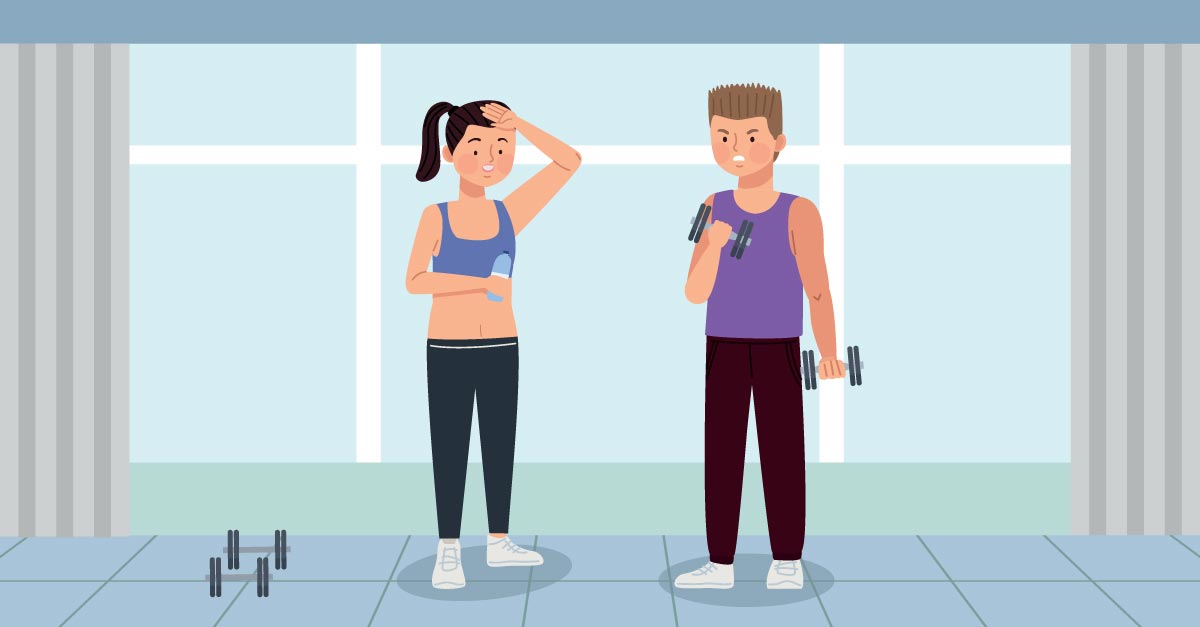Getting sick with a cold or other infection can put you on the sidelines of your workout plans. You may want to keep the momentum going but will working out do more harm than good while you’re under the weather? Keep reading to learn more about what experts say about exercising while sick.
What Happens When You’re Sick?
Your body works hard to protect you from viruses and bacteria set on getting you sick. When they break through your defense systems, you’re left feeling less than great for a few days or weeks. Your immune system tries to clear out invading pathogens by raising your body temperature and creating inflammation. This is why you may have a fever, chills, and muscle aches while you’re sick.
Your body is under more stress than normal when you’re sick — meaning you may feel fatigued and need plenty of rest. This may not leave much behind for you to hit the gym. The best thing you can do is listen to your body’s needs. If you’re still set on getting to your workout, take the following steps to do so safely.
Do a “Neck Check”
The phrase “feeling sick” can mean several different things — to some, it’s a runny nose, and to others, it’s the stomach flu. This can make it confusing as to when you should call it quits with exercising. Doctors typically recommend doing a “neck check” on your symptoms.
Some infections and illnesses are limited to the upper part of your body. If you’re only feeling sick above the neck, you should be good to go with mild exercise. This applies if you’re dealing with a stuffy or congested nose, coughing, sore throat, or earache.
If your symptoms can be found below your neck, it’s best to stay home. Fever, chest congestion, upset stomach, diarrhea, and fatigue are all good reasons to give your body time to rest. Your immune system is under stress trying to fight your illness, and it needs all the energy it can get.
You may have heard of the myth that you can “sweat out” being sick, but this couldn’t be further from the truth. According to physicians at New York University Langone Health, there’s currently no evidence showing that intense exercise helps you recover from being sick. In fact, pushing your body too hard while it’s trying to fight an infection may make things worse.
Modify Your Exercise While Sick
It’s important to remember that just because you pass the neck check test, it doesn’t mean your body is ready for an all-in workout. Consider cutting your efforts down to conserve some energy while still getting your heart rate up. Instead of running 3 miles, run 1 mile, or reduce your weightlifting sets down from 5 to 3. Taking a lighter recovery day or even a few days off from exercising won’t affect your overall fitness level.
Make Sure to Stay Hydrated
Infection with COVID-19 and the flu (influenza) puts you at risk of dehydration. Add vigorous exercise to the mix, and you can quickly lose the water your body needs. It may be best to skip out on your hot yoga class or other exercise you know makes you sweat.
If you choose to exercise while sick, make sure to drink plenty of water before, during, and after. You may feel the effects of dehydration and mistake it for sickness long after your body has cleared away the infection. It’s also important to rehydrate with electrolytes like sodium and potassium that you lose through sweat from fevers and exercise.
Be Conscious of Others
If you’re dealing with an upper respiratory infection, COVID-19, or the flu, it’s best to stay home and avoid getting others sick. Most people are contagious for several days after they first notice symptoms, which means they can pass their infections on to others.
The Cleveland Clinic provides a general outline for when it’s safe to return to the gym:
- The common cold: Wait at least 72 hours (3 days) after your symptoms go away
- The flu: Avoid coming in contact with others for the first 3 to 4 days after your symptoms begin; some people can be contagious for up to a week
- COVID-19: Current Centers for Disease Control and Prevention (CDC) guidelines recommend staying home for at least 5 days after you test positive for COVID-19
Stuck at home for the time being? Look for fun, new ways to exercise from the comfort of your house! Try a circuit of bodyweight exercises like lunges, push-ups, and sit-ups to get you started. Brush the dust off your treadmill in the basement or take a jog around your neighborhood (while being careful to avoid close contact with the neighbors).

